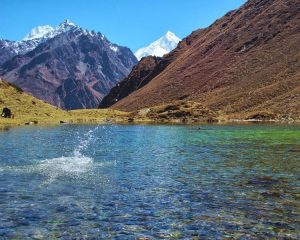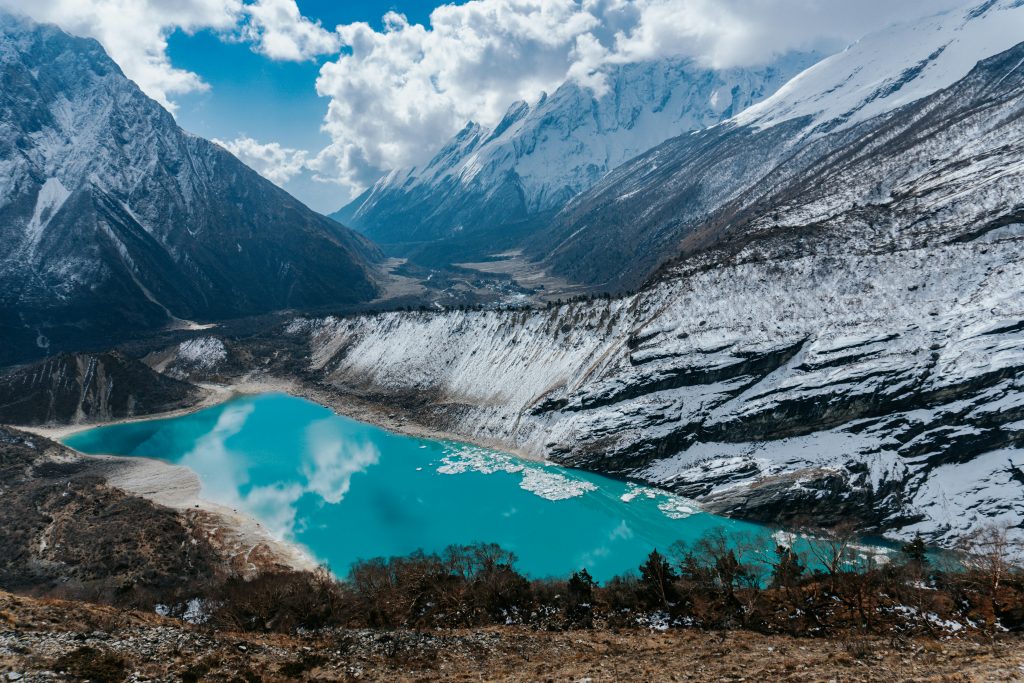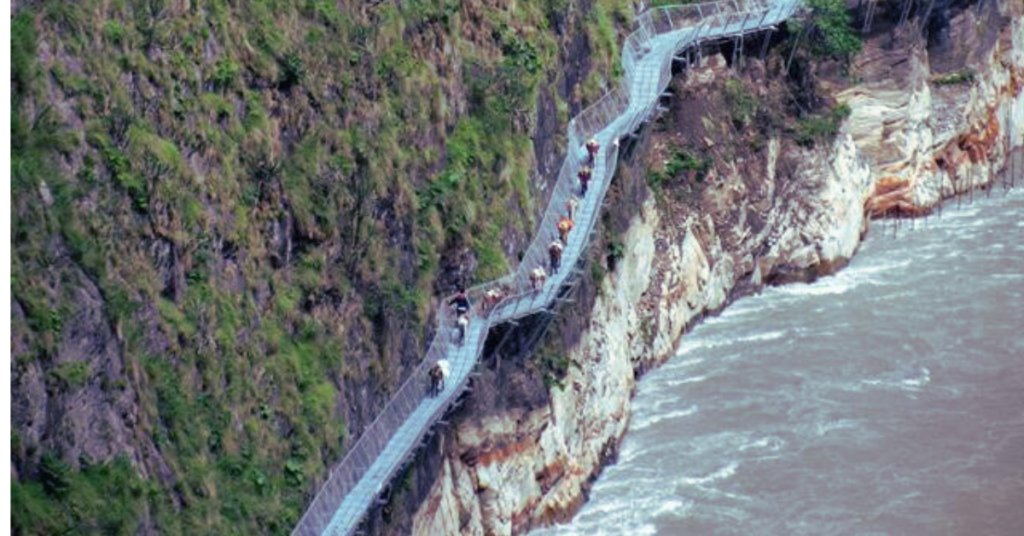Beneath the towering presence of Ganesh Himal, sheltered by ridges that reach towards the heavens, lies the enchanting Tsum Valley, a hidden gem in the heart of the Himalayas. Tsum Valley is a sacred pilgrimage site and is known as the “hidden valley of happiness,” making it an ideal destination for people looking for tranquility and connection to ancient traditions.
Tsum Valley is one of the stunning destinations that beckons adventurers from around the world. The valley offers incredible trekking routes with stunning mountain vistas, making it a paradise for trekkers and adventurers seeking an off-the-beaten-path destination. This blog will delve into the compelling reasons why Tsum Valley should be on every adventurer’s list.
A Glimpse into Tsum Valley

Tsum Valley, located in the Gorkha District of Nepal, is renowned for its rugged beauty and vibrant Tibetan culture. The valley is often referred to as a “hidden gem” because of its remote location and relatively few visitors compared to other popular trekking regions in Nepal. The lower Tsum Valley is located at an altitude of 2,000m and upper Tsum Valley is situated at an altitude of around 3,600 meters and is surrounded by some of the highest peaks in the world, including Ganesh Himal and the Manaslu range. This geographical setting makes it an ideal destination for adventure seekers and nature lovers alike.
Manaslu Conservation Area
Manaslu Conservation Area is home to some of the most dramatic landscapes in Nepal, including Mount Manaslu, the eighth-highest peak in the world. It offers stunning views of snow-capped mountains, dense forests, and pristine rivers. Manaslu Conservation Area is a haven for wildlife that includes endangered species like the snow leopard, red panda, and Himalayan musk deer and rich biodiversity including pine and rhododendron forests and valleys. It’s a paradise for nature lovers and wildlife enthusiasts.

The region is inhabited by ethnic communities such as the Tibetan-influenced Nupri and the Gurungs, who maintain traditional lifestyles. Visitors can experience authentic local culture, including festivals, monasteries, and daily life. The visitors can encounter many Mani walls and monasteries on their way to Tsum valley. It offers trekking routes that are considered to be one of Nepal’s most challenging and scenic trekking routes. The trek takes you through remote villages, past ancient monasteries, and over the Larkya La Pass, offering an incredible adventure.
Unlike more crowded trekking routes such as the Annapurna and Everest regions, Manaslu Conservation Area offers a more remote, less commercialized trekking experience, ideal for those seeking solitude and connection with nature. The area is rich in Tibetan Buddhism, with several centuries-old monasteries like Rachen Gompa and Mu Gompa. These sacred sites add a spiritual dimension to the natural beauty. As a protected area, it emphasizes sustainable tourism and conservation, making it a destination that balances ecological preservation with cultural heritage.
History
Tsum Valley, often referred to as the “Hidden Valley of Happiness,” is steeped in a rich history that intertwines spirituality, culture, and isolation. Tsum Valley remained largely unknown to the outside world until it was officially opened for trekking in 2008. Its remote location, near the Tibetan border, allowed it to develop a unique blend of Tibetan Buddhism and traditional Himalayan culture, relatively untouched by modern influence for centuries.
Historically, Tsum Valley has served as a center of Tibetan Buddhist culture. The valley’s roots in Buddhism date back over 1,000 years, when Padmasambhava, the revered Buddhist saint, is believed to have meditated in the caves surrounding the valley. Monasteries such as Rachen Gompa and Mu Gompa, which still stand today, were established centuries ago and continue to be active centers of religious practice. These monasteries house ancient Buddhist scriptures, murals, and relics, preserving the valley’s spiritual heritage.
For centuries, Tsum Valley has been a pilgrimage site for both Tibetans and locals, known for its sacred status. The Beyul, or hidden valley concept in Tibetan Buddhism, has shaped its spiritual significance. It is said that Milarepa, a legendary Tibetan yogi, visited Tsum and blessed the region, giving it a mystical aura that still attracts spiritual seekers and pilgrims today.
The valley’s history is not only shaped by its spiritual past but also by its cultural isolation. Due to its rugged terrain and harsh climate, Tsum Valley remained inaccessible for much of its history, with trade and communication limited to Tibet. This isolation preserved the valley’s unique Tibetan culture, language, and traditions, which remain a core part of daily life for the Tsumba people. The deep spiritual roots of the valley, combined with its relative seclusion, have made it a living museum of Tibetan Buddhist practices, where rituals, festivals, and daily life reflect ancient traditions.
Today, Tsum Valley’s history and culture are integral to its identity as a trekking destination. Its rich past, combined with its spiritual importance and unique traditions, offers visitors not just a physical journey but a chance to connect with the valley’s deep cultural and religious heritage.
Cultural Significance
Tsum Valley is home to the Tsumba people, who have preserved their rich Tibetan culture for centuries, creating a vibrant tapestry of traditions and customs. The valley is adorned with ancient monasteries, including the renowned Rachen Gumba and Mu Gumba, which serve as spiritual havens for both the local community and visiting pilgrims. These monasteries are not only architectural marvels but also hold immense cultural significance, housing sacred relics and ancient texts that offer profound insights into Tibetan Buddhism.
Visitors to Tsum Valley can immerse themselves in vibrant festivals such as Lhabab Duchen and Saka Dawa, where the essence of local customs comes alive through colorful ceremonies, traditional music, and dance. Engaging with the community during these festivities allows travelers to witness firsthand the warmth and hospitality of the Tsumba people, deepening their understanding of this unique culture.
Additionally, exploring the valley’s daily life—whether through visiting local homes, participating in traditional practices, or simply enjoying the breathtaking scenery—provides a holistic experience that goes beyond trekking. This cultural immersion in Tsum Valley offers a rare opportunity to connect with a way of life that has thrived in harmony with the mountains for generations.
Pristine Nature and Scenic Beauty
One of the most striking features of Tsum Valley is its breathtaking natural beauty, captivating every visitor who ventures into this hidden gem of the Himalayas. The valley is adorned with lush green terraced fields that cascade down the mountainsides, creating a patchwork of vibrant colors that change with the seasons. Crystal-clear rivers meander through the landscape, their gentle sounds harmonizing with the rustling leaves and chirping birds, providing a soothing soundtrack to your trek. You’ll encounter awe-inspiring vistas at every turn—from the majestic, snow-capped peaks of the Himalayas, towering above like ancient guardians, to the vibrant wildflowers that blanket the meadows in spring, transforming the landscape into a colorful tapestry.
Birdwatchers will find joy in spotting a wide array of avian species, including the dazzling Himalayan monal, the national bird of Nepal, known for its striking plumage, and the elusive Tibetan snowcock, which can be heard calling from the cliffs. The rich biodiversity of the valley is further complemented by a variety of medicinal herbs and unique plant species that thrive in its diverse ecosystems.
The changing seasons bring different beauty to Tsum Valley. In spring, the meadows burst into a riot of colors, with wildflowers like rhododendrons and primulas blooming in abundance. Summer offers a lush green landscape, ideal for trekking and exploring the region’s hidden trails. Autumn showcases golden hues as the leaves change, while winter blankets the valley in a serene layer of snow, transforming it into a peaceful wonderland.
Whether you’re trekking through verdant forests, crossing high suspension bridges that offer breathtaking views of the valleys below, or simply soaking in the serene ambiance, the pristine nature and scenic beauty of Tsum Valley create an unforgettable experience. Each moment spent in this remarkable landscape invites reflection and connection with the natural world, leaving an indelible mark on your spirit long after your journey ends.
Adventure Opportunities
For adventure seekers, Tsum Valley offers a plethora of outdoor activities. The trekking routes are relatively less crowded than other popular trails in Nepal, allowing for a more intimate experience with nature. Treks through the valley typically take you along ancient trade routes, through picturesque villages, and past stunning landscapes, making it a perfect destination for those looking to escape the hustle and bustle of everyday life.
The trek to Tsum Valley can be customized to fit different fitness levels, from moderate to challenging. This flexibility makes it accessible to a wide range of adventurers, from casual hikers to seasoned trekkers. This is a route that people take to fetch yarchagumba so, this also adds to an adventurous vibe that this place offers.
In addition to trekking, visitors can also explore opportunities for rock climbing, mountain biking, and cultural immersion in the local communities. Engaging with the Tsumba people, learning about their traditions, and participating in their daily activities adds an enriching layer to your adventure.
Hospitality
The locals of Tsum Valley are known for their warm and welcoming nature, a reflection of the valley’s untouched beauty. Despite the remote location and limited resources, they offer visitors the best of what they have—often food that is different from what they consume daily. This act of generosity speaks volumes about their pure-hearted hospitality. Influenced heavily by Tibetan culture, the people of Tsum Valley provide a rare glimpse into life in the Himalayas, where tradition and community are at the heart of everything. Their kindness extends far beyond mere courtesy, making every visitor feel as if they are part of this beautiful mountain landscape.
High Suspension Bridges
The high suspension bridges found along the Tsum Valley trek are engineered to withstand the region’s challenging weather conditions and rugged topography. These bridges typically consist of a sturdy cable system that supports a deck, allowing trekkers to traverse deep gorges and fast-flowing rivers safely.
Crossing these bridges can be a thrilling experience, as they sway gently with the wind and provide a unique vantage point to admire the surrounding valleys and towering peaks. The Budhi Gandaki River, which flows through the valley, is often crossed via these impressive structures, connecting trekkers to remote settlements and enhancing the overall adventure.
Cantilever Bridges
In addition to suspension bridges, you will also encounter cantilever bridges throughout your trek. These bridges are supported on one side and extend outward, providing a dramatic way to cross narrow gorges and ravines. The design of cantilever bridges allows for greater flexibility and stability, making them ideal for the rugged terrain of Tsum Valley.

Walking across these cantilever bridges gives trekkers an opportunity to experience the thrill of being suspended above steep cliffs, with the sounds of nature echoing below. Each crossing brings you closer to the heart of the valley, where local culture and the stunning Himalayan landscape converge.
The Journey to Tsum Valley
Reaching Tsum Valley requires a journey through the scenic landscapes of Nepal. Most travelers begin their adventure in Kathmandu, the capital city, where they can immerse themselves in the rich history and culture of the country. From Kathmandu, a scenic drive takes you to Arughat, the starting point for the trek to Tsum Valley.
The trek itself can take around 5 to 10 days or more, depending on your route and pace. As you ascend into the valley, you’ll be greeted by stunning views and the warm hospitality of the local communities. This journey is not just about reaching a destination; it’s about enjoying the incredible landscapes, rich culture, and the sense of tranquility that Tsum Valley offers.
Conclusion
During a visit to Tsum Valley, travelers can immerse themselves in the vibrant traditions and festivals of the local Tsumba community, offering a rare cultural experience. Trekking through the stunning natural landscapes—featuring towering mountains, rivers, and terraced fields—promises a once-in-a-lifetime adventure. For those seeking more excitement, activities like rock climbing provide thrilling challenges amidst the breathtaking scenery. Visitors can also explore ancient monasteries, connecting deeply with the spiritual heritage of Tibetan Buddhism, while discovering the region’s rare flora and fauna, making Tsum Valley a truly unforgettable destination.
Tsum Valley is a captivating destination that combines breathtaking natural beauty with rich cultural heritage. Whether you’re seeking adventure, serenity, or a deeper understanding of Tibetan Buddhism, Tsum Valley has something to offer every traveler. This hidden gem should undoubtedly be on every adventurer’s list. You can check out our package related to this area by clicking here.




